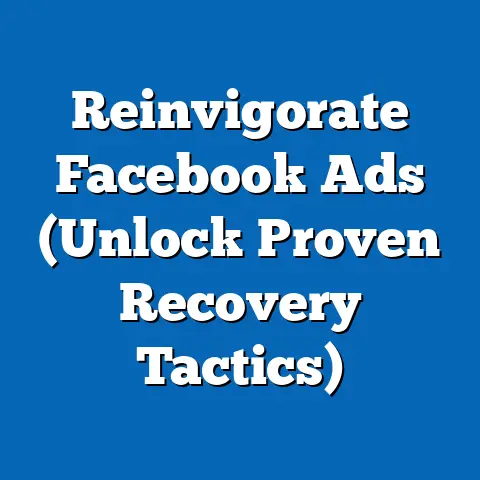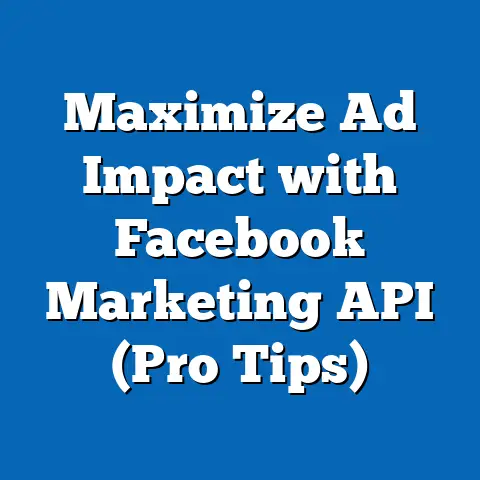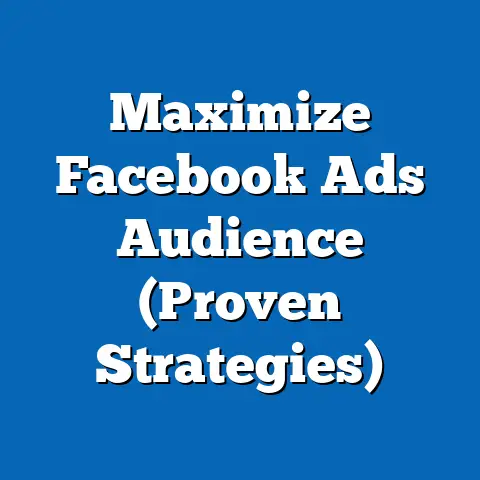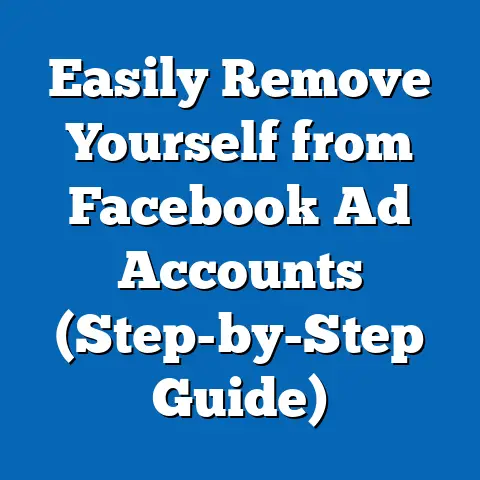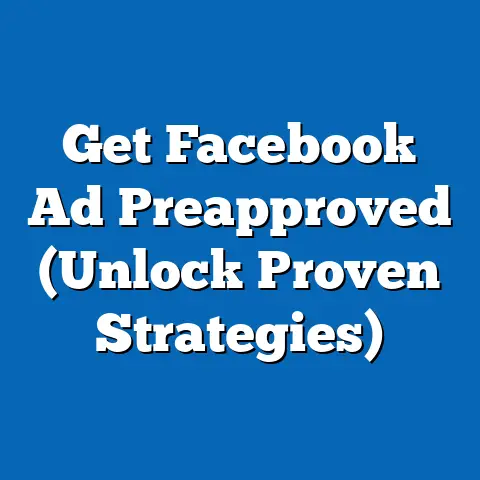Boost Sales with Facebook Ads Funnels (Proven Strategies)
Have you ever wondered why some businesses seem to thrive on Facebook while others struggle to make even a single sale? I’ve seen it time and time again – businesses throwing money at ads, hoping for a miracle, only to be met with disappointment. The truth is, success on Facebook isn’t about luck; it’s about strategy. It’s about understanding the customer journey and guiding them through a well-defined sales funnel. In this guide, I’ll break down how you can use Facebook Ads funnels to transform potential customers into loyal buyers and, most importantly, boost your sales.
Understanding Facebook Ads Funnels
A sales funnel, in its simplest form, is a marketing model that illustrates the journey a potential customer takes from initial awareness of your brand to ultimately making a purchase. Think of it as a series of stages, each designed to nurture and guide the prospect closer to becoming a paying customer. When we talk about Facebook Ads funnels, we’re essentially applying this framework to our advertising efforts on the platform.
The beauty of a funnel is its structure. It’s not about blasting the same message to everyone. It’s about delivering the right message, at the right time, to the right person. This is especially crucial on a platform like Facebook, where users are bombarded with information and distractions.
Here’s a breakdown of the typical stages in a Facebook Ads funnel:
- Awareness: This is the very top of the funnel, where your goal is to introduce your brand or product to a broad audience. You’re essentially casting a wide net to attract potential customers who might not even know they need what you’re offering.
- Interest: Once you’ve captured their attention, the next step is to pique their interest. This involves providing valuable content, showcasing the benefits of your product or service, and building a relationship with your audience.
- Decision: At this stage, potential customers are considering whether or not to make a purchase. Your goal is to address any remaining concerns, provide social proof, and offer compelling reasons to choose your brand over the competition.
- Action: This is the bottom of the funnel, where the magic happens. Your goal is to convert interested prospects into paying customers. This involves making it easy for them to make a purchase, providing clear calls-to-action, and offering excellent customer service.
Why is a structured funnel so important? Because it mirrors the natural buying process. People rarely stumble upon a product and immediately buy it. They need to be informed, engaged, and convinced. A well-designed funnel provides that guidance and builds trust along the way. Without a funnel, your ads are essentially random shots in the dark, hoping to hit a target. With a funnel, you’re aiming with precision and increasing your chances of success exponentially.
Takeaway: A Facebook Ads funnel is a structured approach to advertising that guides potential customers through the buying journey, from initial awareness to final purchase.
Why Facebook Ads?
In today’s digital landscape, Facebook remains a dominant force. It’s not just a social media platform; it’s a powerhouse for advertising, boasting a massive user base and unparalleled targeting capabilities. I’ve seen businesses of all sizes leverage Facebook Ads to achieve remarkable results, and here’s why I believe it’s still a must-have in any marketing strategy:
- Vast User Base: With billions of active users, Facebook offers access to a massive pool of potential customers. Whether you’re targeting a niche audience or a broad demographic, you’re likely to find them on Facebook.
- Unparalleled Targeting Capabilities: Facebook’s advanced targeting options allow you to reach specific audiences based on demographics, interests, behaviors, and even custom audiences built from your own customer data. This level of granularity ensures that your ads are seen by the people most likely to be interested in your product or service.
- Cost-Effectiveness: Compared to other advertising platforms, Facebook Ads can be incredibly cost-effective, especially when you’re targeting the right audience and optimizing your campaigns effectively.
- Versatile Ad Formats: Facebook offers a variety of ad formats, including image ads, video ads, carousel ads, and collection ads, allowing you to create engaging and visually appealing content that resonates with your target audience.
- Measurable Results: Facebook Ads Manager provides detailed analytics and reporting tools, allowing you to track your campaign performance, measure your ROI, and make data-driven decisions to optimize your advertising efforts.
Let’s talk numbers. Studies have shown that Facebook ads can generate a significant return on investment. For example, a recent report by Statista showed that the average ROI for Facebook ads is $8.32 for every $1 spent. This means that businesses are seeing a substantial return on their advertising investment.
Real-world Example: I worked with a local bakery that was struggling to attract new customers. They were relying on word-of-mouth and traditional advertising methods, but their sales were stagnant. We created a Facebook Ads funnel targeting local residents interested in desserts and baked goods. The initial ads focused on raising awareness of the bakery and its delicious offerings. We then retargeted those who showed interest with ads featuring special promotions and customer testimonials. Within a few months, the bakery saw a significant increase in foot traffic and sales, thanks to the power of Facebook Ads.
Takeaway: Facebook Ads offer a powerful combination of a vast user base, advanced targeting capabilities, cost-effectiveness, and measurable results, making it an essential platform for businesses looking to boost sales.
Crafting Your Facebook Ads Funnel
Now, let’s dive into the nitty-gritty of crafting an effective Facebook Ads funnel. Remember, each stage requires a different approach and a tailored message.
Stage 1: Awareness
The goal here is simple: get noticed. You want to introduce your brand to people who might not even know you exist.
- Compelling Ads: Your ads need to be eye-catching and engaging. Use high-quality visuals, attention-grabbing headlines, and concise copy that clearly communicates your value proposition. Think about what makes your brand unique and highlight that in your ads.
- Targeting: This is where Facebook’s targeting capabilities truly shine. Don’t just target everyone! Use demographic targeting, interest targeting, and behavioral targeting to reach the people most likely to be interested in your product or service.
Example: Let’s say you’re selling organic skincare products. You could target women aged 25-55 who are interested in natural beauty, skincare, and healthy living.
Pro Tip: Experiment with different ad formats to see what resonates best with your audience. Video ads tend to be highly engaging, but image ads can also be effective if they’re visually appealing and well-designed.
Stage 2: Interest
Now that you’ve captured their attention, it’s time to nurture their interest and build a relationship with your audience.
- Retargeting Ads: Retargeting is a powerful tool that allows you to show ads to people who have already interacted with your brand, such as visiting your website or liking your Facebook page. This keeps your brand top-of-mind and encourages them to learn more.
- Lead Magnets: Offer valuable content, such as eBooks, webinars, or free trials, in exchange for their email address. This allows you to build your email list and continue nurturing them with targeted messages.
- Storytelling: People connect with stories. Share your brand story, customer testimonials, or behind-the-scenes content to build a connection with your audience and make them feel like they’re part of your community.
Example: You could create a retargeting ad that offers a free sample of your organic skincare product to people who have visited your website. Or, you could create a lead magnet offering a free guide to achieving healthy, glowing skin.
Pro Tip: Use Facebook Pixel to track website visitors and create custom audiences for retargeting.
Stage 3: Decision
At this stage, potential customers are considering whether or not to make a purchase. Your goal is to address any remaining concerns and provide compelling reasons to choose your brand.
- Limited-Time Promotions: Create a sense of urgency by offering limited-time promotions, such as discounts or free shipping.
- Testimonials: Showcase positive reviews and testimonials from satisfied customers. Social proof is incredibly powerful in influencing purchasing decisions.
- Clear Calls-to-Action: Make it easy for potential customers to take the next step by using clear and concise calls-to-action, such as “Shop Now,” “Learn More,” or “Get a Free Quote.”
- Landing Page Optimization: Ensure that your landing pages are optimized for conversions. This means having a clear and concise message, a visually appealing design, and a seamless user experience.
Example: You could run a Facebook ad featuring a limited-time discount on your organic skincare product, along with a customer testimonial highlighting its effectiveness.
Pro Tip: Use A/B testing to experiment with different calls-to-action and landing page designs to see what performs best.
Stage 4: Action
This is the final stage of the funnel, where you convert interested prospects into paying customers.
- Easy Purchase Process: Make it as easy as possible for customers to make a purchase. Offer multiple payment options, provide clear shipping information, and ensure that your website is mobile-friendly.
- Cart Abandonment Recovery: Use email marketing to recover abandoned carts. Send targeted emails to customers who added items to their cart but didn’t complete the purchase, offering a discount or free shipping to incentivize them to complete the transaction.
- Post-Purchase Follow-Ups: Continue engaging with customers after they make a purchase. Send thank-you emails, ask for feedback, and offer exclusive discounts on future purchases. This helps build customer loyalty and encourages repeat business.
Example: You could send a follow-up email to customers who purchased your organic skincare product, offering a discount on their next purchase and asking for a review.
Pro Tip: Use Facebook Pixel to track conversions and optimize your ad campaigns based on the results.
Takeaway: Crafting an effective Facebook Ads funnel requires tailoring your message and approach to each stage of the customer journey, from initial awareness to final purchase.
Proven Strategies for Optimizing Your Facebook Ads Funnel
Creating a funnel is just the first step. To truly maximize your ROI, you need to continuously optimize your campaigns. Here are some proven strategies:
- A/B Testing: A/B testing involves creating two versions of an ad (A and B) and showing them to different segments of your audience to see which one performs better. Test different headlines, visuals, calls-to-action, and targeting options to identify what resonates best with your audience.
- Data-Driven Decisions: Don’t rely on gut feelings. Use Facebook Ads Manager to track your campaign performance and make data-driven decisions to optimize your advertising efforts. Pay attention to metrics such as click-through rate (CTR), conversion rate, and cost per acquisition (CPA).
- Scaling Successful Campaigns: Once you’ve identified a winning ad campaign, scale it up by increasing your budget and expanding your targeting options. However, be careful not to scale too quickly, as this can negatively impact your ROI.
- Continuous Refinement: The Facebook Ads landscape is constantly evolving, so it’s important to stay up-to-date on the latest trends and best practices. Continuously refine your funnel based on your performance data and industry insights.
Example: I once worked with an e-commerce client who was struggling to generate sales from their Facebook Ads. We implemented A/B testing and discovered that ads featuring user-generated content (photos of customers using their products) performed significantly better than ads featuring professional product photos. We then scaled up the user-generated content ads and saw a dramatic increase in sales.
Pro Tip: Use Facebook’s Automated Rules feature to automate tasks such as pausing underperforming ads or increasing bids on high-performing ads.
Takeaway: Optimizing your Facebook Ads funnel requires continuous testing, data analysis, and refinement to ensure that you’re maximizing your ROI.
Common Mistakes to Avoid
Even with the best strategies in place, it’s easy to make mistakes that can derail your Facebook Ads efforts. Here are some common pitfalls to avoid:
- Targeting Too Broadly: Don’t try to target everyone. Focus on reaching the people most likely to be interested in your product or service.
- Neglecting Mobile Optimization: The majority of Facebook users access the platform on their mobile devices, so it’s essential to ensure that your ads and landing pages are optimized for mobile.
- Ignoring Ad Fatigue: If you’re running the same ads for too long, your audience will become blind to them. Refresh your ads regularly with new visuals and copy.
- Not Tracking Conversions: If you’re not tracking conversions, you won’t know which ads are actually driving sales. Use Facebook Pixel to track conversions on your website and optimize your campaigns accordingly.
- Lack of Patience: Building a successful Facebook Ads funnel takes time and effort. Don’t get discouraged if you don’t see results immediately. Be patient, persistent, and willing to learn from your mistakes.
Example: I once saw a business running Facebook Ads that were targeting the entire United States. Their budget was quickly depleted without generating any meaningful results. By narrowing their targeting to specific regions and demographics, they were able to significantly improve their ROI.
Pro Tip: Use Facebook’s Ad Library to see what ads your competitors are running and get inspiration for your own campaigns.
Takeaway: Avoiding common mistakes such as targeting too broadly, neglecting mobile optimization, and ignoring ad fatigue can significantly improve the performance of your Facebook Ads funnel.
Conclusion
A well-structured Facebook Ads funnel is a powerful tool for boosting sales and growing your business. By understanding the customer journey, tailoring your message to each stage of the funnel, and continuously optimizing your campaigns, you can effectively turn potential customers into loyal buyers.
Don’t be afraid to experiment, test different strategies, and learn from your mistakes. The Facebook Ads landscape is constantly evolving, so it’s important to stay up-to-date on the latest trends and best practices.
Now, it’s time to put these strategies into action. Start by defining your target audience, crafting compelling ads, and building a structured funnel that guides potential customers through the buying journey. Monitor your results, make data-driven decisions, and continuously refine your funnel to maximize your ROI. With the right strategies in place, you can unlock the full potential of Facebook Ads and achieve remarkable results. Good luck!

